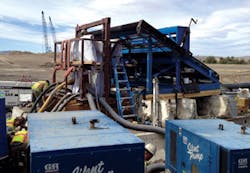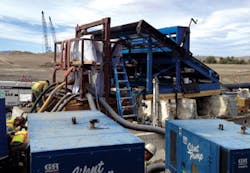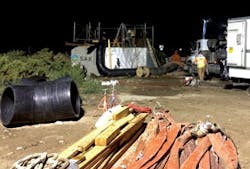A Good Bet: Cured-in-Place Pipe Delivers Winning Solution for Reno Rehab Project
By Jim Kalishman
The City of Reno, Nev., thrives on people playing the odds, but officials had no desire to gamble when the city's water infrastructure was at stake. So when it came time to rehabilitate the siphons that run under the Truckee River and the pipelines that serve the main water treatment plant, the desert community wanted to make sure great care was taken to keep its water clean.
The Truckee River, the source of which is the outlet of Lake Tahoe, is a major attraction and is heavily used for recreational pursuits such as pleasure boating, whitewater rafting and fly-fishing. In addition, the waters of the Truckee supply drinking water to the 225,000-plus people who call Reno home, and they terminate about 40 miles away at Pyramid Lake.
Years ago, siphons were built under the river to channel sewage from collector lines to an interceptor trunk, installed in 1976, that ends on the East side of the river. In 2013, after 37 years of service, it was expected to last another 13 years. However, inspections revealed the pipe to be heavily corroded and missing much of its interior coating. The city had to act to ensure that all efforts were taken to protect the river waters flowing above from a major subterranean pollution event.
With a project occurring so close to a significant venue like the river, a major objective was to not disturb the premises either operationally or environmentally. While the primary goal was to properly rehabilitate the pipelines to achieve a long, functional life, it was important to the customer to minimize the term of any bypass, limit local traffic blockage and generally operate with minimal disruption. Therefore, the city of Reno made sure to consider repair options for the siphons and pipelines that resulted in minimal interruption. Cured-in-place pipe (CIPP), a proven industry solution that satisfied both structural and operational requirements, was the rehabilitation method ultimately selected for the project.
Adding to the previously-listed requirements and challenges was the variety of lengths, diameters, locations, and types of pipelines that a contractor needed to address. The specs included 45,000 linear feet of diameters ranging from 8 to 72 inches. In addition, another 3,500 linear feet of 60 inches and 3,500 linear feet of 72 inches that fed directly into the treatment plant would need relining. The longest was over 2,000 linear feet of 60 inches -- a major test for anyone delivering a solution. Finally, the contractor would need to address the two 48-inch siphons and another 24-inch siphon under the Truckee River.
"This was likely the most environmentally and logistically challenging CIPP project put out to bid by the city of Reno in the last 15 years," said Thayne Loendorf, project manager at Brown and Caldwell, the largest environmental engineering consulting specialist in the U.S. "It was complicated by lining siphons under the Truckee River, proximity to a wastewater treatment plant, high ground water levels, and the need to coordinate activities with an adjacent highway project and to bypass high-volume sanitary sewer flows."
SAK Construction of O'Fallon, Mo., took on the multi-faceted project, successfully using CIPP to repair the various-sized pipes and three siphons without disruption to the river or to the community. In evaluating the project, SAK recognized that the location of the pipelines under the river posed a large complication for bypassing. It was determined that it would be impossible to bypass over the river, so an alternate solution was needed to address the flow of the operating lines. A subcontractor for SAK, Munson Pump Services of Anderson, Calif., came to the rescue.
Munson's experience handling large-volume bypass situations proved invaluable as it detoured around the 60-million-gallons-per-day (MGD) line under the Truckee, and at times, past the entire treatment plant, for almost six months.
When bypassing wasn't an option in other areas of the project, SAK's skill in handling complex CIPP jobs was a key to success. At times, the only viable option was for the company to perform CIPP relining in live flow conditions in the junction structures next to the line. The maneuver was one that only a handful of the nation's most experienced CIPP contractors could successfully complete.
Prior to relining, SAK relied on another subcontractor, Pro Pipe, to televise and clean the lines. In addition to the CIPP work, the job included rehab of all the manholes. National Coating, another subcontractor, teamed with SAK to address the manhole repairs. They also coated all the headworks, grit chambers and siphon structure while the plant was bypassed.
"We knew going into it that this was a difficult project with many potential pitfalls, but that's exactly the kind of work we thrive on, and that makes the end result even more satisfying," said Ryan Broyles, SAK operations manager. "I'm very proud of our team and partners and how we worked together to find solutions that best served the client."
Today, the city of Reno is delighted to have a newly- rehabilitated pipeline system that no longer has it playing the odds with the priceless water that serves the daily needs of its growing population.
"The experience, professionalism, communication skills, and aptitude of SAK's personnel helped promote a culture of teamwork with the city, the construction manager and subcontractors to complete this project on time and on budget," said Loendorf.
Overall, the project was one that left everyone holding a winning hand.
About the Author: Jim Kalishman is chief information officer of SAK Construction, LLC. Based in O'Fallon, Mo., and with regional offices in Baltimore, Md., Sacramento, Calif., and Tampa, Fla., SAK solves the challenge of maintaining and restoring aging water, sanitary and oil and gas pipeline infrastructure for the municipal, energy and industrial markets across the U.S. For more information, visit www.sakcon.com.
More WaterWorld Current Issue Articles
More WaterWorld Archives Issue Articles



